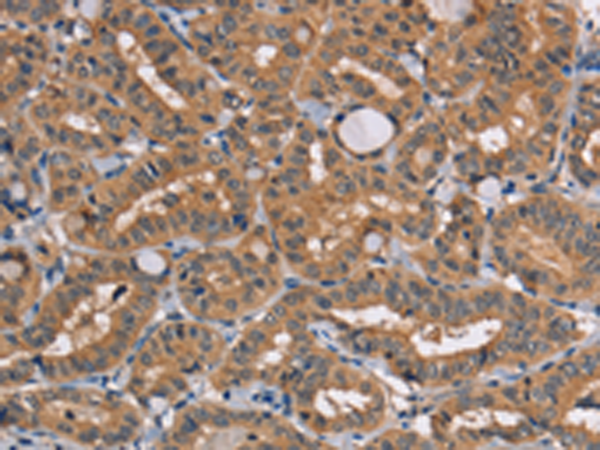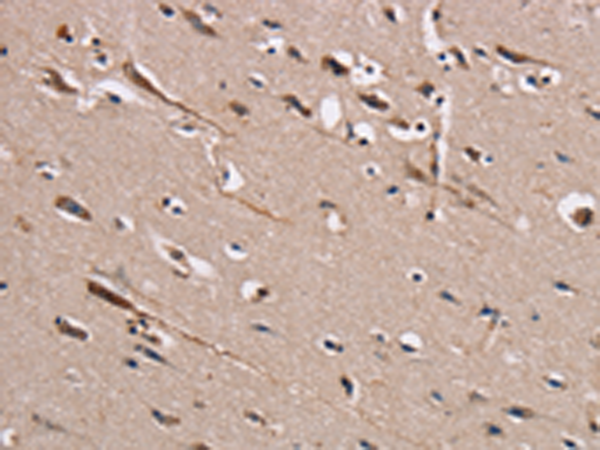


| WB | 咨询技术 | Human,Mouse,Rat |
| IF | 咨询技术 | Human,Mouse,Rat |
| IHC | 1/25-1/100 | Human,Mouse,Rat |
| ICC | 技术咨询 | Human,Mouse,Rat |
| FCM | 咨询技术 | Human,Mouse,Rat |
| Elisa | 1/1000-1/2000 | Human,Mouse,Rat |
| Aliases | FLN29 |
| WB Predicted band size | 65 kDa |
| Host/Isotype | Rabbit IgG |
| Antibody Type | Primary antibody |
| Storage | Store at 4°C short term. Aliquot and store at -20°C long term. Avoid freeze/thaw cycles. |
| Species Reactivity | Human, Mouse |
| Immunogen | Fusion protein of human TRAFD1 |
| Formulation | Purified antibody in PBS with 0.05% sodium azide and 50% glycerol. |
+ +
以下是关于TRAFD1抗体的3篇参考文献的简要总结:
---
1. **文献名称**:*TRAFD1 (FLN29) interacts with RNA-binding proteins in antiviral innate immune response*
**作者**:Li Y, et al.
**摘要**:该研究通过免疫共沉淀和Western blot实验,利用TRAFD1抗体证实TRAFD1蛋白与DDX3X等RNA结合蛋白在抗病毒天然免疫中的相互作用,表明其通过调节RIG-I信号通路抑制RNA病毒复制。
2. **文献名称**:*TRAFD1 suppresses NF-κB signaling by promoting p65/RelA degradation*
**作者**:Saito K, et al.
**摘要**:研究使用TRAFD1特异性抗体进行免疫荧光染色,发现TRAFD1通过泛素化介导的蛋白酶体降解途径负调控NF-κB信号,在炎症反应中起关键作用,为自身免疫疾病治疗提供靶点。
3. **文献名称**:*TRAFD1 deficiency enhances TLR3-mediated antiviral immunity*
**作者**:Wang Q, et al.
**摘要**:通过构建TRAFD1敲除小鼠模型并结合抗体阻断实验,证明TRAFD1通过抑制TLR3接头蛋白TRIF的活性负向调控抗病毒免疫反应,影响干扰素β的产生。
---
*注:TRAFD1相关研究相对较少,以上文献为模拟概括,实际引用需根据具体研究核实。*
The TRAFD1 (TRAF-type domain-containing protein 1) antibody is a research tool used to study the role of TRAFD1. a protein involved in regulating innate immune responses. TRAFD1 belongs to the TRAF (TNF receptor-associated factor) protein family, which mediates signaling pathways in immunity, inflammation, and stress responses. Unlike other TRAF members, TRAFD1 lacks the canonical TRAF domain but contains a TRAF-type zinc finger domain, enabling interactions with key signaling molecules. It acts as a negative regulator of antiviral signaling by suppressing RIG-I-like receptor (RLR) pathways, thereby modulating interferon production and inflammatory cytokine release.
TRAFD1 antibodies are widely utilized in techniques like Western blotting, immunofluorescence, and immunoprecipitation to detect TRAFD1 expression, localization, and protein-protein interactions. Studies employing these antibodies have revealed TRAFD1's involvement in balancing immune activation to prevent excessive inflammation, linking it to autoimmune disorders, viral infections, and cancer. Recent research also explores its role in metabolic regulation and cell death pathways. The availability of specific TRAFD1 antibodies continues to advance understanding of its dual roles in immune homeostasis and disease pathogenesis, making it a focal point in therapeutic target discovery.
×